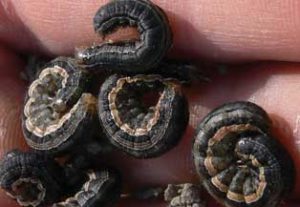 So far, areas south of the 401 appear to be hardest hit by armyworm in southern and central Ontario. Eastern Ontario is starting to report armyworm in wheat so producers in those areas should be out scouting fields. We have been seeing quite a size variation in the armyworm larvae this year which is likely due to staggered egg laying by the adults that came up from the south. You will likely see both small and large larvae in the filed when you scout. Remember, insecticides DO NOT do a good job of controlling armyworm larvae that are 1 inch long (2.5cm) or larger. There is no economic benefit to spraying armyworm when they are this big. If you find that the majority of larvae are less then 1 inch AND numbers are over threshold, then an insecticide application should be considered. Most pesticides registered for amryworm must contact the larvae to kill them. If you are in a position where pesticide application can be made SPRAY IN THE EVENING OR AT NIGHT when the armyworm are active.
So far, areas south of the 401 appear to be hardest hit by armyworm in southern and central Ontario. Eastern Ontario is starting to report armyworm in wheat so producers in those areas should be out scouting fields. We have been seeing quite a size variation in the armyworm larvae this year which is likely due to staggered egg laying by the adults that came up from the south. You will likely see both small and large larvae in the filed when you scout. Remember, insecticides DO NOT do a good job of controlling armyworm larvae that are 1 inch long (2.5cm) or larger. There is no economic benefit to spraying armyworm when they are this big. If you find that the majority of larvae are less then 1 inch AND numbers are over threshold, then an insecticide application should be considered. Most pesticides registered for amryworm must contact the larvae to kill them. If you are in a position where pesticide application can be made SPRAY IN THE EVENING OR AT NIGHT when the armyworm are active.
What Now?
Wheat: Leaf feeding in wheat that is past the soft dough stage will not effect yields so insecticide treatment is not necessary. Spraying armyworm that are 1 inch or over will not kill enough larvae to significantly reduce feeding damage.
Hay: For armyworm in hay fields, cutting is a better method of control then using insecticides at this point. The armyworm may still do some feeding as the hay wilts but they will move out of the field after a day or two.
Corn: As the hay is cut and the wheat matures armyworm larvae will start to move out these fields to find food. Start looking around the field edges of corn for armyworm moving into the field.
Corn up to the 7 leaf stage can take a fair amount of defoliation before significant yield loss is noticed as long as the growing point is not damaged. In corn, scout 20 plants in five areas of the field and take note of the size of the armyworms. Look at the field edges, especially those bordering hay or wheat crops. The best time to scout is in the evening when the armyworm is most active. For corn plants past the 6 leaf stage, if you are finding more than 50% of the plants with damage and they are infested with larvae smaller than 1 inch (2.5cm), an insecticide treatment may be needed. Because the larvae are moving in from the edge of the field, a perimeter spray may be sufficient.
Bt hybrids may offer some protection from armyworm.
Armyworm: The Next Generation
The second generation of armyworm typically does not cause much of a problem in Ontario. There is much more greenery for the moths to lay eggs on and this tends to dilute the population over a much larger area. Also, natural enemy numbers are higher after the first generation and they can help to keep populations in check. That being said, hay producers should keep an eye out for armyworm in the grasses this summer in case a few hotspots develop.